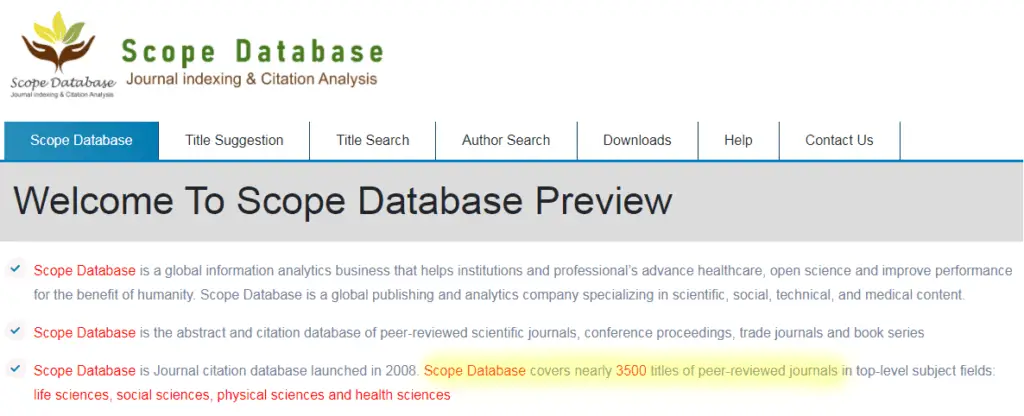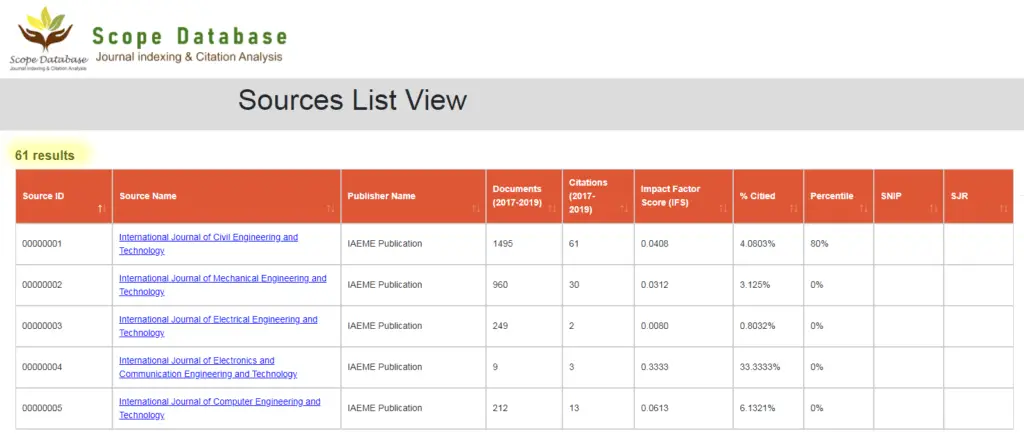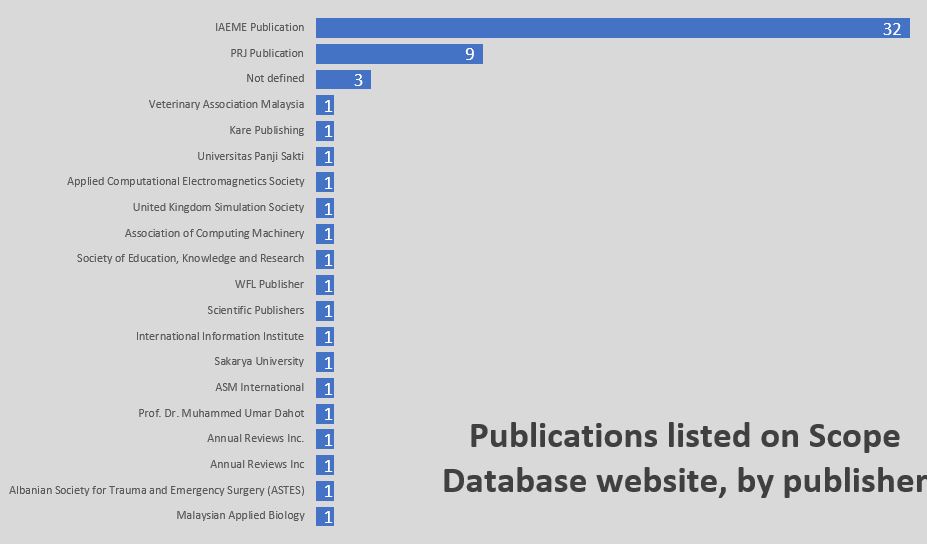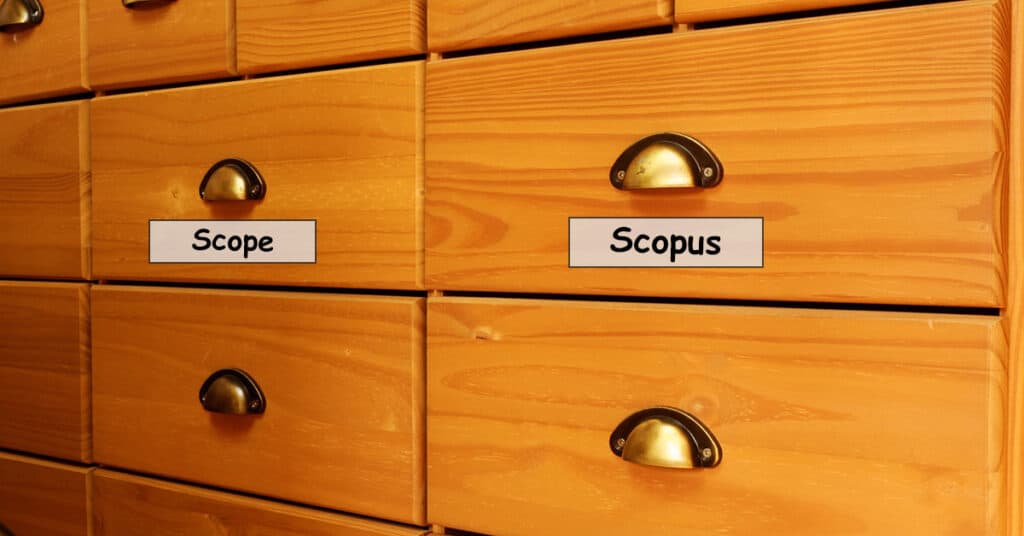Whilst researching another article, we came across something called Scope Database. This is not something that we had seen before, so we made a note to investigate it further and this article is the result of that investigation.
One of the things that concerned us was how parts of the web site looked like Scopus.
The Scope Database web site, in some places, looks the same as the Scopus web site. As far as we can see there is no relationship between the Scope Database and Scopus and we can only conclude that Scope Database is trying to fool the unwary researcher.
In this article, we look at Scopus and Scope Database and show why we think that Scope Database is trying to give the illusion (even sub-consciously) that it is associated with Scopus. We also look at the journals that are indexed by Scope Database, in order to give a view of how many, and the type of journals, that are indexed.
What is Scopus?

Scopus is one of the leading bibliographic search engines, with the other popular one being Web of Science. Scopus has a free service, as we well as a subscription based product, which many if not most, universities subscribe to. The subscription model provides access to many additional features which are useful to the academic community.
Scopus maintains the largest citation database of peer-reviewed literature, which includes journals, conference proceedings and books. It also provides an impact factor for each journal that it indexes. This is important to many researchers as they either wish to, or are under instruction to, publish in Scopus and/or Web of Science journals. Therefore, researchers are often under pressure to target journals that are indexed by Scopus, or that they believe are indexed by Scopus.
If you want to know how to check whether a journal is in the Scopus database, these two videos might be of help.
What is Scope Database?

To quote from their web site "Scope Database is a global information analytics business that helps institutions and professional’s advance healthcare, open science and improve performance for the benefit of humanity. Scope Database is a global publishing and analytics company specializing in scientific, social, technical, and medical content."
The menus
If you look at the Scopus and Scope Database web site and read some of the content it is apparent that the two services are not associated with each other. Neither mentions the other, and searching each web site you cannot see locate anything that appears to refer to the other. So what is the problem?
The menu bars are one potential issue.
Scopus menu

The image above is the menu bar on the Scopus home page. For those of you that access Scopus regularly, you will probably recognize it, as it is as much about branding as anything else. Clicking on each on each piece of text, or icon, links to another page.
Scope Database menu

By way of comparison, this image is the menu bar from the Scope Database web site. We are sure that you can see the similarities, which gives this part of the web site the same look and feel.
We may be wrong, but we cannot help feel that the design of the Scope Database menu bar is not an accident and, although it is not identical, it is similar enough to draw the conclusion that the Scope Database used the Scopus menu bar as inspiration for its own menu look and feel. If we were being really cynical, we might say that Scope Database have copied it to make it appear as similar to the Scopus web site as possible.
Comparing the home screens
You might be wondering about the rest of the home screen. To be fair, they do not look similar. We have not shown the home pages here, but we have linked to screenshots that we took on 13 Jan 2021, not only so that you can see them (should you wish to do so), but also so that we have a record of what the home pages looked like when we wrote this article.
The home page of Scopus can be seen here and the home page of Scope Database can be seen here. These are screenshots (as at 13 Jan 2021), if you want to see what they look like now, see here (for Scopus) and here (for Scope Database).
Other Observations
Active menus
We thought it would be useful to look at the menu options in a little more detail.
The six items on the Scopus menu are all active, and lead to pages that you would expect.
Looking at each of the menu items on the Scope Database page, we note the following.

The menu items leads to a page where you can search by author. For completeness, a screenshot of the full page is available here (as at 14 Jan 2021).

This menu items leads to a page that lists the sources that are indexed by Scope Database. We say more on this below.




These four menu items all lead no where. That is, they do nothing and you stay on the same page.
Digging a little deeper, the link (which you can see when you hover over the menu item) says “javascript:void(0);“. Essentially, this says that the menu item is undefined. For those that are interested, you can read more details here.
The only conclusion that we can reach from these observations is that Scope Database has made their menu look like the menu on the Scopus web site, but has not linked up four of the menu items. We can only assume that aim is to make it look like Scopus, rather than make it a fully functioning system.
Scope Database sources
Figure 1 shows an extract of the Scope Database home page. It states that the Scope Database contains almost 3,500 peer-reviewed journals.

If you follow Scope Database “Sources” menu, this leads to a page that says that the Scope Database has 61 journals in its database (see Figure 2). An image of the complete sources page is available here.

We cannot work out why one page of the web site says that they have 3,500 journals in their database, yet only 61 show up when you look at the sources?
It is also noticeable that there are columns for “SNIP” and “SJR”. There are very much Scopus terms and we are not sure why they appear in this table? In any case, none of the rows contain any values.
Analysis of sources
Looking at the 61 journals that are listed, we thought that it might be useful to delve a little deeper. Figure 3 shows a bar chart, which shows the number of journals by publisher. We have also made the complete list available, just in case you are interested, but also so that there is a record on the day we wrote this article (14 Jab 2021).

It is noticeable that the list is dominated by one publisher (IAEME Publication), which has 32 journals registered with Scope Database. PRJ Publication has nine journals listed [Note: When we tried to access the PRJ Publication web site, it led to a page suggesting that it no longer exists. This may be fixed at some time after this article has been published]. The three “Not defined” journals are actually conferences. The other 17 publishers have one journal each.
It is not the purpose of this article to look more deeply into the publishers but, as we always do, when we come across open access publishers, we add them to our “Keep in View” list and, when we have the time, we will look at those publishers.
Conclusion
Whilst investigating another article we came across Scope Database. We had not seen this before.
We may have ignored it, but their menu structure caught our eye as it looked very much like the Scopus menu. We’ll let you decide if the similarities could have happened by chance or it was deliberately copied to try and give the illusion that Scope database is somehow associated with Scopus.
We cannot work out why they state that Scope Database has 3,500 journals in its database, yet only 61 are listed when you look at their sources. Moreover, the database listing has (empty) columns for “SNIP” and “SJR”. These are Scopus terms, which do not seems to have any meaning within the context of Scope Database. As far as we could see, there is no other reference to these terms on their web site.
Please consider supporting us by becoming a patron

Thank you for reading this article. If you would like to support the work we do, please consider becoming one of our patrons.
With your support, it will enable us to deploy some of the ideas that we have, and will also enable us to work more closely together. As an example, we will look at journals and/or publishers that you propose. You can read more here.


